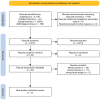Feature representation in analysing childhood vaccination defaulter risk predictors: A scoping review of studies in low-resource settings
- PMID: 40737269
- PMCID: PMC12310020
- DOI: 10.1371/journal.pdig.0000965
Feature representation in analysing childhood vaccination defaulter risk predictors: A scoping review of studies in low-resource settings
Abstract
Childhood vaccination saves millions of lives yearly, yet over a million children in low-and middle-income countries die from vaccine-preventable diseases each year. Predicting childhood vaccination defaulter risk with analytical models requires understanding how to represent different individual demographics, community structures, and environmental factors that feed input data. This review explores features for analysing childhood vaccination defaulter risk in low-resource settings with a focus on feature encoding, engineering and representation. Articles published from 2018 to January 2025 were searched using PubMed, Google Scholar, ACM Digital Library, and references from the searched articles. Search was limited to low- and middle-income countries, focusing on African countries. We included studies that utilised either statistics or machine learning for analysis. Of the 4,174 articles retrieved, 55 were eligible, 41 were then excluded after full-text review, and 4 were added from references. Cross-cutting features included maternal education and health service utilisation. Novel features included community rates of poverty, maternal education and maternal unemployment. Variations in encoding strategies, engineering techniques and feature representation were marginal. Categorical data were mainly encoded as binary inputs, while features with high dimensionality like socio-economic status were condensed by using principal component analysis. A review of existing feature representations can serve as a feature construction reference to improve the exploitation of machine learning techniques within the context of childhood vaccination defaulter risk prediction. Future studies can exploit other representations different from binary encoding, like frequency encoding, to introduce elements of weighting into multi-categorical features.
Copyright: © 2025 Odei-Lartey et al. This is an open access article distributed under the terms of the Creative Commons Attribution License, which permits unrestricted use, distribution, and reproduction in any medium, provided the original author and source are credited.
Conflict of interest statement
The authors have declared that no competing interests exist.
Figures


References
LinkOut - more resources
Full Text Sources
